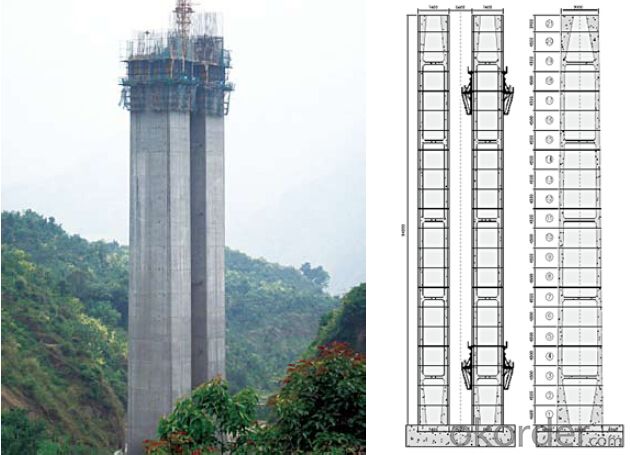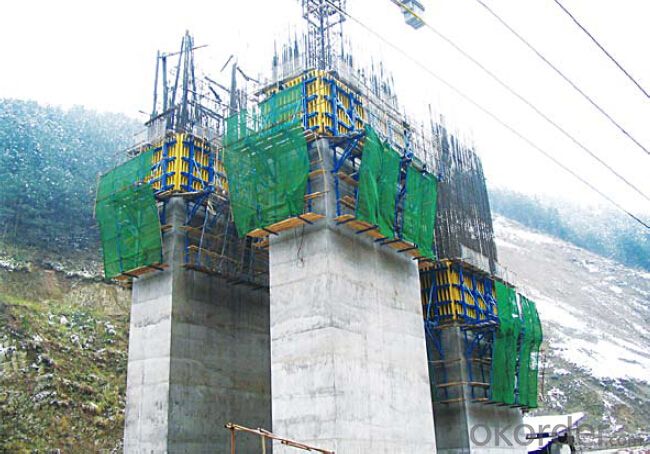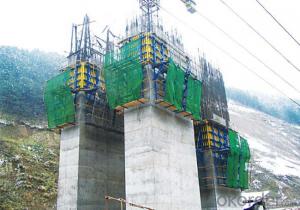Climbing Bracket CB210 for formwork and scaffolding system
- Loading Port:
- Tianjin
- Payment Terms:
- TT OR LC
- Min Order Qty:
- 50 m²
- Supply Capability:
- 1000 m²/month
OKorder Service Pledge
OKorder Financial Service
You Might Also Like
Climbing Bracket CB240 & CB210
They are framework brackets for supporting large-area wall formwork.
Typical applications for the CB240&CB210 are pier and column/shear wall/core walll/ in the
building.
CB210 has smaller size than CB240, it will be cost effective in some condition.
Characteristics:
◆ High bearing capacity
The high loading capacity of the brackets allow very large scaffold units. This saves the number
anchor points required as well as reducing climbing times.
◆ Simple moving procedure by crane
Through the strong connection of formwork together with the climbing scaffold, both can be moved
as a single climbing unit by crane. Thus valuable time-savings can be achieved.
◆ Fast striking process without a crane
With the retrusive set, large formwork elements can also be retracted quickly and a minimum of
effort.
◆ Safe with work platform
The platforms have assembled firmly with bracket and will be climbing together, without scaffolding
but can work safely in spite of your high location.
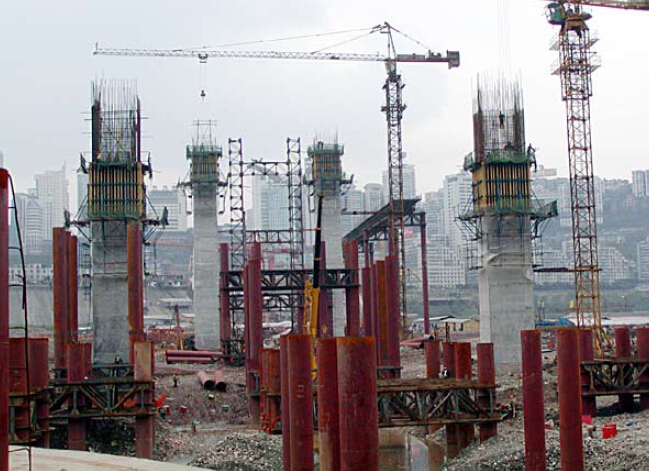
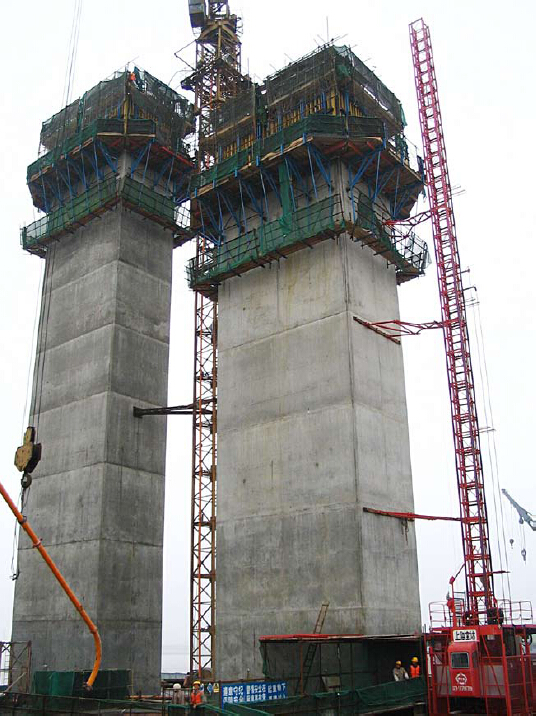
- Q: Can steel formwork be used for curved or complex structures?
- Indeed, curved or intricate structures can be constructed using steel formwork. The employment of steel formwork provides abundant flexibility and adaptability, rendering it well-suited for fashioning diverse shapes and designs. Its robustness and sturdiness enable it to maintain its form, even when employed in curvilinear or intricate structures. Moreover, steel formwork can be conveniently fabricated and modified to meet particular project specifications, rendering it a perfect selection for erecting complex designs.
- Q: Is steel formwork suitable for projects with high concrete pressure?
- Yes, steel formwork is suitable for projects with high concrete pressure. Steel formwork is known for its strength and durability, making it capable of withstanding the pressure exerted by the wet concrete during the pouring and curing process. It can handle the weight and pressure of the concrete without deforming or collapsing, ensuring the stability and integrity of the structure being built. Steel formwork also provides a smooth and consistent surface finish to the concrete, which is essential for projects that require high-quality finishes. Additionally, steel formwork can be reused multiple times, making it a cost-effective option for projects with high concrete pressure.
- Q: Can steel formwork be used in residential housing projects?
- Certainly, residential housing projects can make use of steel formwork. Steel formwork, a robust and flexible formwork system, is widely employed in construction endeavors, including those pertaining to residential housing. It boasts numerous advantages, such as its exceptional strength, reusability, and capacity to fabricate intricate shapes and designs. Particularly well-suited for projects demanding precision and resilience, steel formwork finds utility in various aspects of residential housing construction, encompassing walls, columns, slabs, and beams. The inclusion of steel formwork in residential housing projects can enhance construction efficiency, diminish labor and material expenses, and ensure consistently high-quality outcomes.
- Q: What are the fire resistance properties of steel formwork?
- Steel formwork has excellent fire resistance properties due to its high melting point and low thermal conductivity. It is able to withstand high temperatures for extended periods of time without losing its structural integrity, making it a safe and reliable choice for construction projects in fire-prone areas.
- Q: What are the environmental considerations of using steel formwork?
- Several factors must be taken into account when evaluating the environmental impact of steel formwork. First and foremost, the production of steel involves extracting iron ore, which can have adverse effects on the environment. Mining activities can cause deforestation, destroy habitats, and lead to soil erosion. Moreover, the extraction process requires a significant amount of energy, often derived from non-renewable sources, resulting in greenhouse gas emissions. Another aspect to consider is the transportation of steel formwork. Due to its weight, transporting steel from the manufacturing site to the construction site can increase fuel consumption and emissions. This is especially true when the construction site is far from the steel manufacturing facility. However, it is worth noting that steel formwork offers several environmental advantages. Steel is a durable material that can be reused multiple times, minimizing the need for new formwork production. This helps reduce the demand for raw materials and waste generation. Additionally, steel formwork can be easily recycled at the end of its lifespan, further reducing its environmental impact. Furthermore, steel formwork is renowned for its strength and stability, which can lead to more efficient construction processes. This, in turn, can result in reduced construction time and lower energy consumption during the building phase. To mitigate the environmental impact of steel formwork, it is crucial to prioritize sustainable practices throughout its lifecycle. This includes sourcing steel from responsible suppliers who prioritize environmental stewardship, promoting the recycling and reuse of formwork, and optimizing transportation and logistics to minimize carbon emissions. Overall, although there are environmental considerations associated with steel formwork, its durability, reusability, and recyclability make it a viable option for sustainable construction practices when managed responsibly.
- Q: Can steel formwork be used for both vertical and horizontal concrete structures?
- Yes, steel formwork can be used for both vertical and horizontal concrete structures. Steel formwork is versatile and strong enough to support the weight of concrete in various orientations, making it suitable for both vertical walls and horizontal slabs.
- Q: Can steel formwork be used for structures with high load-bearing requirements?
- Yes, steel formwork can be used for structures with high load-bearing requirements. Steel is known for its high strength and durability, making it a suitable choice for heavy-duty applications. Steel formwork provides excellent support during the construction process, allowing for the creation of structures that can withstand significant loads. Additionally, steel formwork offers superior dimensional stability, ensuring that the structure maintains its shape and can bear the required loads over time. Combined with proper reinforcement and design, steel formwork can effectively handle high load-bearing requirements in various construction projects.
- Q: Can steel formwork be used for projects with complex geometries?
- Indeed, projects with intricate geometries can make use of steel formwork. Thanks to its high strength and durability, steel formwork proves to be suitable for managing complex shapes and intricate designs. The fabrication and customization of steel formwork can be easily achieved to meet the project's specific requirements, enabling the creation of complex geometries while maintaining structural integrity. Furthermore, steel formwork guarantees exceptional dimensional stability, ensuring the precise and accurate construction of complex shapes. Given its versatility and flexibility, steel formwork emerges as the preferred option for projects involving intricate and complex geometries.
- Q: Are there any specific safety guidelines for steel formwork installation?
- Yes, there are specific safety guidelines for steel formwork installation. These guidelines include ensuring proper training and supervision of workers, using appropriate personal protective equipment, inspecting the formwork for any defects or damage before installation, following proper lifting and handling techniques, and securing the formwork to prevent collapse or displacement. Additionally, adherence to local building codes and regulations is crucial for maintaining safety during steel formwork installation.
- Q: Can steel formwork be used for airport runway construction?
- Yes, steel formwork can be used for airport runway construction. Steel formwork is a durable and versatile option that can withstand heavy loads and provide a smooth surface for concrete placement. It is commonly used in large-scale construction projects like airports due to its strength, stability, and ability to be reused multiple times, making it an ideal choice for runway construction.
Send your message to us
Climbing Bracket CB210 for formwork and scaffolding system
- Loading Port:
- Tianjin
- Payment Terms:
- TT OR LC
- Min Order Qty:
- 50 m²
- Supply Capability:
- 1000 m²/month
OKorder Service Pledge
OKorder Financial Service
Similar products
Hot products
Hot Searches


